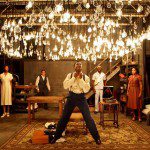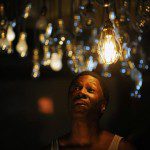‘Invisible Man’: Still With Us
By • November 6, 2012 0 1726

“Invisible Man,” Oren Jacoby’s adaptation of Ralph Ellison’s iconic and National Book Award-winning novel of a nameless black man’s experience in and of America, is a wonder to behold.
In the novel’s incarnation as a play, now at the Studio Theatre, directed by Christopher McElroen, co-founder of the Classical Theatre of Harlem, in a co-production with the Huntington Theatre Company, you find yourself thinking and feeling on any number of levels—and wondering about the rest of the audience.
Gifted young actor Teagle F. Bougere says, “I am an invisible man,” intoning the opening words of the novel which remains a classic of American and African-American literature. It is a stylistic landmark, a powerful experience in reading. And, with some critical caveats, it’s an equally powerful but also very different, theatrical experience.
Bougere plays a young black man in the 1920s or early 1930s, not yet graduated from a so-called Negro college, who comes to live in Harlem in search of work and identity. “Invisible Man” as a novel is high-style, almost surreal and certainly poetic. It’s not really a naturalistic work; it’s episodic, a novel of experience. The experience, the biblical and harsh lessons that come from it, is the essence of what it was, and sometimes still is, to be black in America. In the invisible man’s world, grandfathers are freed slaves, the poor live in squalor, and education, as preached by the gospel of Booker T. Washington, is a vehicle for advancement, if not equality.
What’s remarkable about the play is adaptor Oren Jacoby has managed to create a play functioning with the words of the novel. Given the high intensity, rolling, often eloquent and thundering, poetic and even abstract nature of Ellison’s writing style, that’s no small feat. There’s little that seems naturalistic about the way the characters—with all the actors, except Bougere, playing several parts—speak. A certain formality, a poetic distance characterizes how characters—black and white—speak, there’s precious little slang or colloquialism here. It’s always, by way of example, “perhaps” not “maybe.”
By the time the young man makes his way to New York, he’s already lost a few illusions—he receives a college scholarship from the white aristos in his southern community, but not before having been forced to be part of a smoker in which blindfolded black men strike out at each other for the entertainment of the white swells. After he accidentally introduced a kind, wealthy trustee to the more sordid examples of black poverty, he’s expelled from school by the wheeling and dealing school president and sent to New York with a bogus letter of introduction.
In Harlem, he gets a job at a paint factory which specializes in a whiter-than-white paint. “You mean white is right, right?” he asks a co-painter. He’s injured in a factory explosion after a fight with his foreman. He’s helped by a kind woman who puts him up in her modest home. Then, after witnessing an eviction of a black family by an Irish cop, he spontaneously discovers a gift for oratory, stirring up a crowd, talking about “the dispossessed.” That feat attracts the attention of a leftist group of organizers called the brotherhood, strongly resembling the active Communist Party of the time, which many Americans, including Ellison and his fellow novelist Richard “Black Boy” Wright found, for a brief time, attractive.
But the experience ends in disaster—for his friends, for the black community of Harlem and for whatever visibility the man might have thought he still had.
The production is haunting, even beautiful. Bougere is passionate—at turns distant and feverish—as the nameless, invisible man. The staging is stunning. When we meet him the hero lives in a small basement apartment, illuminated by hundreds of light bulbs, making it seem like a consecrated carnival booth. The set by Troy Hourie is remarkable: it doesn’t just shine with lights but is a constantly moving back drop of historical black and white imagery.
The rest of the cast—the intense, lean Brian D. Coats, who plays the grandfather and other parts, the sly coquettish Julia Watt as an enticing white woman, Edward James Hyland as both the well-meaning trustee and a short-tempered Irish cop, and Johnny Lee Davenport in his turn as the idealistic Tod Clifton—leave indelible impressions.
The play—as a drama, not a novel—comes in a way to a halt, and we’re left with the thought, as he insists, that “who knows, on a lower frequency, I speak for you.”
You’re also left with some other thoughts—what this play and that novel mean today in the age of a black president, how it might resonate, say, in the Chicago teacher’s strike; what it has to tell us in this borderline, hateful campaign, what it and its resonating language might sound to young black kids. Given the audience, a full house, was generously 90 percent white, you hope Ellison does indeed speak to and for all of us. Because in this city and in this America, there is a growing divide, and there are still invisible people.
- Teagle F. Bougere in Invisible Man. | Astrid Reiken
- Astrid Reiken



